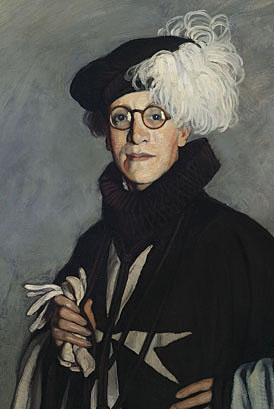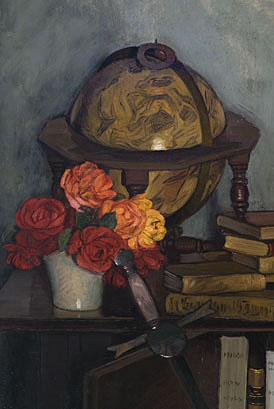The piece of the month of June 2008
PORTRAIT OF JOSÉ MARÍA DE HUARTE Y JAÚREGUI (1937), BY IGNACIO ZULOAGA
Esther Elizalde Marquina
Chairof Navarrese Heritage and Art
Recently, the Museum of Navarre, in its effort to enrich and fill in the contemporary art holdings of its collection, has acquired the "Portrait of José María de Huarte y Jáuregui", a work by the Basque painter Ignacio Zuloaga (Eibar, 1870-Madrid, 1945). The work, painted in 1937, belongs to the last period of the artist from Eibar, only eight years before his death, during which he lived in Zumaya, where he must have met Don José María de Huarte, commander-in-chief of the National Army at place in Zarauz during that period. The work was exhibited in various exhibitions held at the New Burlington Galleries in London (1938), in Bilbao (1939) and in Zaragoza (1946).

Portrait of José María de Huarte y Jaúregui, 1937. Museum of Navarra. Oil on canvas, 215 x cm (Image courtesy of the Museum of Navarra).
José María de Huarte y Jáuregui (Pamplona, 1898-Madrid, 1969) was born in the family home on Calle Mayor in Pamplona, being educated in a cultured environment, where he immediately became interested in the field of Humanities. Following the family tradition, he studied Teaching, continuing with the programs of study of Philosophy and Letters, to fill in his training university with the degree program of Law. From 1927 to 1936 he occupied the position of chief archivist of the Royal and General file of Navarre; coinciding with such appointment, he was designated director of the bulletin of the old Commission of Monuments of Navarre, as well as Academic Correspondent of the Royal Academies of History and Fine Arts of San Fernando.
When he married Doña Isabel González de Olañeta e Ibarreta, widow of the Duke of Montpensier, he was Marquis consort of Valdeterrazo and Antrines, with Greatness of Spain. Previously, he had already been named Knight of the Order of Malta and had received numerous decorations and honorary distinctions.The effigy was a great scholar in the most diverse matters, specialized in Genealogy, Heraldry and Nobiliary subjects, and author of multiple publications on these disciplines, among which we can highlight: El Nobiliario del Reino de Navarra. Executed Nobility in the Royal Courts of Court and committee of Navarre (1519-1832), a work carried out together with the King of Arms Don José de Rújula, where they made known a series of invaluable unpublished documents concerning the lineages, armorial palaces and ancestral homes of the Kingdom.
In 1936 he joined the National Army as an officer, becoming Commander-in-Chief of place of Zarauz, when it was taken by the national forces; it must have been at that time when the artist Ignacio Zuloaga and Don José María met, giving rise to a first drawing in which the portrayed person appeared seated in military uniform.

Portrait of José María de Huarte y Jaúregui, 1937 (detail)
In the canvas, José María de Huarte appears full-length and slightly turned towards the viewer, with his left arm slightly bent and resting on his hip, while his right arm firmly holds his gloves. His stylized figure against the neutral background marks a clear vertical line on the canvas. A portrait of classical composition, in which Zuloaga sample his great mastery for drawing; the strokes of his brush, very sure, define concisely the profile of the effigy, without elements that distract the viewer's gaze, except for the cabinet full of books. All of this with a sober coloring that emphasizes the dignity and, if possible, the dignity of the distinguished personage.
Zuloaga gave his models a certain grandeur of representation, a monumentality by capturing the essential features of the portrayed: his character, for which he sacrifices details, features and delicacy and, instead, he emphasizes with energy the gesture, the action and the look; the look above all, since, as Lafuente Ferrari points out, Zuloaga was the painter of the eyes. The artist himself had stated that in his portraits he sought character, psychological penetration. So it is in this case, where the expressive force resides in the energetic gaze of José María de Huarte, in the line of contemporary portraits such as that of Manuel de Falla (1932).
Likewise, the strong personality of the sitter is expressed through the gesture and the attitude he adopts to show himself to the viewer; both the face and the way he holds his gloves and places his left hand on his hip are vehicles of expression. To this is added the fact of appearing dressed in the habit of the Order of Malta, (biretta and black capitular mantle with the Maltese cross) in front of a small open cabinet, where we can see different books, armorials and parchments, which tell us of the erudition of the illustrious character, of his programs of study in heraldry, genealogy and other subjects treated throughout his life. And of this symbolic background, one of the volumes located on the floor stands out, open on a page, marked by the sword resting on the furniture. This marks the coat of arms of Huarte, the arms of the Lord of Huarte of the town of Araquil and the adjoining house of Irañeta, consisting of a shield quartered in cross, whose first and fourth quarters, gules, presents a gold anchored cross and, the second and third, gold, with five bells of azure placed in sotuer, alluding directly to its origins and, as already mentioned, to its programs of study in heraldry.

Portrait of José María de Huarte y Jaúregui, 1937 (detail)
In final, the portrait of José María de Huarte constitutes a good sample of the capacity as a portraitist that characterizes the last pictorial stage of Ignacio Zuloaga, where at the same time that he delves into the essence of the character, he surrounds him with a symbolic background that provides the necessary social and cultural context.
bibliography
AA.VVV., "Ignacio Zuloaga (1)", Basque painters and sculptors of yesterday, today and tomorrow, publishing house La Gran Enciclopedia Vasca, Bilbao, vol. 3, pp. 281-323.
AA.VVV., "Ignacio Zuloaga (2)", Basque painters and sculptors of yesterday, today and tomorrow, publishing house La Gran Enciclopedia Vasca, Bilbao, vol. 12, pp. 2-32.
Arozamena, J.M., Ignacio Zuloaga. El pintor, el hombre, San Sebastian, Sociedad Guipuzcoana de ediciones y publicaciones S.A., 1970.
Huarte y de Jáuregui, J.M. de, and Rújula y de Ochotorena, J. de, Nobiliario del Reino de Navarra. Nobility executed in the Royal Courts of Court and committee of Navarre, Pamplona, Sancho El Fuerte Publications, 2002.
Lafuente Ferrari, E., La vida y el arte de Ignacio Zuloaga, Barcelona, publishing house Planeta 1990.
Lafuente Ferrari, E., "Los retratos de Zuloaga", Príncipe de Viana, nº 11, 1950, pp. 41-73.
Martinena Ruiz, J.J., La archivística en Navarra, Pamplona, Government of Navarra, 2003.
Rodríguez del Castillo, J., Ignacio Zuloaga, Zarauz, 1970.
Other sources:
Inventario de Fondos Museográficos. Museum of Navarre.
